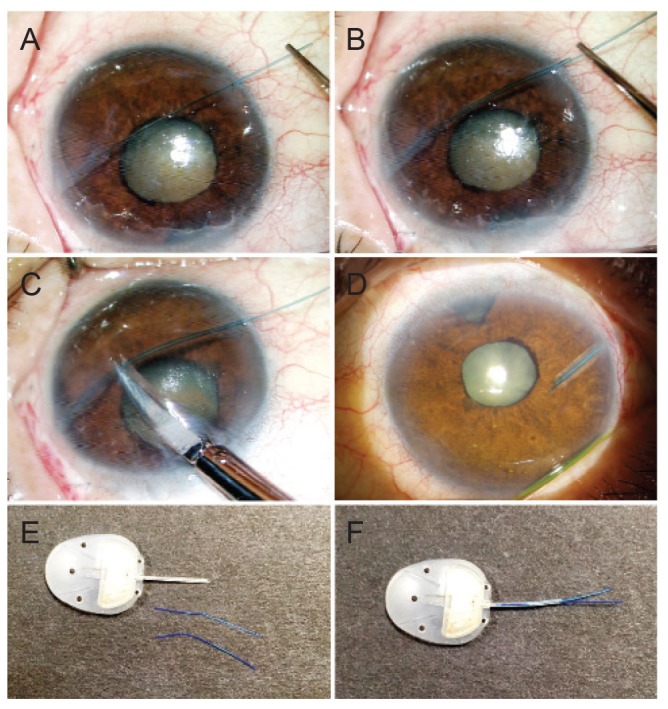Dear Editor,
Despite the introduction of valved devices and tube ligation, ocular hypotony remains an important complication after tube surgery. When postoperative ocular hypotony occurs due to overdrainage through the tube, tube occlusion by ligation or stenting may be required. To perform the ab externo approach, the conjunctival wound should be reopened, and this may increase the risk of bleeding, fibrosis, or device exposure at the operation site. Thus, when conjunctival scarring is excessive or the conjunctiva is thin, the ab externo approach is limited. When tube length is sufficient to be extracted from the anterior chamber through the corneal incision, the anterior chamber-positioned part of the tube can be ligated and repositioned into the anterior chamber. However, ligation of the tube at a focal area may not induce sufficient and predictable outflow control [1]. Previous studies reported that intraluminal stenting produced effective and predictive outflow control [2,3,4]. Thus, ab interno tube stenting may be an effective method to manage postoperative ocular hypotony. We present a case of ocular hypotony after Ahmed glaucoma valve (AGV; New World Medical, Rancho Cucamonga, CA, USA) implantation that was resolved by stenting using two 5-0 nylon threads with an ab interno approach.
A 50-year-old man with neovascular glaucoma underwent AGV implantation to control intraocular pressure (IOP). Despite previous trabeculectomy and maximal medical treatment, his IOP was greater than 35 mmHg. Intra- operatively, the superior-temporal conjunctiva was incised, and a body plate was placed approximately 12 mm posterior to the corneal limbus. The tube was ligated with 8-0 vicryl and entered into the anterior chamber. After AGV implantation, the IOP ranged from 7 to 10 mmHg without complications. However, two weeks after the surgery, IOP suddenly decreased to 2 mmHg, and the patient's vision decreased from 20 / 400 to hand motion. The anterior chamber was shallow, and hypotony maculopathy was identified. Given that the ocular hypotony occurred 2 weeks postoperatively, excessive aqueous drainage through the tube due to loosening of tube ligation was suspected. To elevate IOP by intraluminal stenting with an ab interno approach, a corneal incision was made opposite the tube. A 5-0 nylon thread was inserted into the tube lumen using forceps (Fig. 1A). In the same manner, the second 5-0 nylon thread was inserted into the tube lumen (Fig. 1B). After making another corneal incision, the nylon threads were cut with scissors (Fig. 1C). To remove the thread, a small portion of it was left protruding from the tube tip (Fig. 1D). After this procedure, IOP was 8, 7, 14, and 29 mmHg at 1, 3, 5, and 10 days, respectively. Timolol/dorzolamide fixed-combination eye drops were applied twice daily, and IOP decreased to 10 mmHg. Both threads were removed 30 days after stenting by retraction. The IOP ranged from 10 to 13 mmHg without IOP-lowering medication for 6 months after this procedure, and vision recovered to 20 / 400.
Tubes can be stented using various suture threads. For instance, in a previous case, a single 4-0 polypropylene thread was used to manage ocular hypotony [5]. Given that the internal diameter of the tube is approximately 300 Āµm, and the 4-0 polyprolene thread diameter is approximately 150 Āµm, stenting with a single 4-0 thread may not induce sufficient IOP elevation in all cases. Thus, we used two 5-0 nylon threads with diameters of approximately 140 Āµm per thread. This method may improve IOP elevation compared to stenting with a single 4-0 thread. When performing tube stenting, cautionis needed so as to not destroy the valve in the body plate with an overly-long stent. After stenting, the intraluminal threads can be inferiorly displaced, and this may cause corneal endothelium irritation. Thus, close observation is needed after this procedure. We suggest that use of a bent thread may reduce the risk of stent displacement (Fig. 1E, 1F). To date, this is the only report of ocular hypotony managed with two 5-0 nylon threads. We think that ab interno tube stenting using two 5-0 nylon threads may be an effective method to manage postoperative ocular hypotony after AGV implantation.




 PDF Links
PDF Links PubReader
PubReader Full text via DOI
Full text via DOI Full text via PMC
Full text via PMC Download Citation
Download Citation Print
Print






